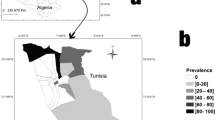Abstract
During the period between February, 2004 and December, 2006, a cross-sectional study was performed to investigate some epidemiological aspects related to camel brucellosis in Jordan. Four hundred twelve camel sera from 37 herds were randomly collected and analyzed using Rose Bengal plate test and complement fixation test. A structured pre-tested questionnaire was administered to collect information on camel herd health and management. A multivariable logistic regression model was constructed to investigate risk factors associated with seropositivity to Brucella antigens. Moreover, the incidence of Brucella-specific abortion was investigated in 7 camel herds located in different locations in Southern Jordan. The true prevalence of Brucella-seropositive in camels was 12.1%. Thirteen (35.1%) herds had at least one positive camel. The seroprevalence of brucellosis in camels was significantly higher in the southern part of Jordan than that in central or northern Jordan. The multivariable logistic regression model on both individual and herd levels revealed large herds and contact with small ruminants as risk factors for Brucella seropositivity. On the other hand, using disinfectants was identified as a protective factor (OR = 0.8; 95% CI: 0.1, 0.9) only on the camel herd level. The incidence of Brucella-caused abortion was 1.9%. Brucella melitensis biotype 3 was isolated from 4 aborted camel fetuses.
Similar content being viewed by others
References
Abbas, B. and Agab, H., 2002. A review of camel brucellosis, Preventive Veterinary Medicine, 55, 47–56.
Abbas, B., Qarawi, A.A. and Al-Hawas, A., 2000. Survey of camel husbandry in Qassim region, Saudi Arabia, Revue d Elevage et de Medecine Veterinaire des Pays Tropicaux, 53, 285–292.
Agab, H. and Abbas, B., 1999. Epidemiological studies on camel diseases in eastern Sudan, World Animal Reviews, 92, 42–51.
Ahmed, W.M. and Nada, A.R., 1993. Some pathological affections of testis and epididymis of slaughtered camels (Camelus dromedaries), International Journal of Animal Sciences, 8, 33–36.
Al Khalaf, S.and El Khaladi, A., 1989. Brucellosis of camels in Kuwait. Comparative Immunology, Microbiology and Infectious Diseases, 12, 1–4.
Al-Majali, A.M., 2005. Seroepidemiology of caprine brucellosis in Jordan, Small Ruminant Research, 58, 13–18.
Al-Majali, A.M., Majok, A., Amarin, N. and Al-Rawashdeh, 2007. Prevalence of, and risk factors for, brucellosis in Awassi sheep in Southern Jordan, Small Ruminant Research, In Press.
Al-Talafhah, A.H., Lafi, S.Q. and Al-Tarazi, Y., 2003. Epidemiology of ovine brucellosis in Awassi sheep in Northern Jordan. Preventive Veterinary Medicine, 60, 297–306.
Alton, G.G., Jones, L.M., Angus, R.D. and Verger, J.M., 1988. Techniques for the Brucellosis Laboratory, (INRA, Paris).
Blasco, J.M., 2006. Existing and future vaccines against brucellosis in small ruminants. Small Ruminant Research, 62, 33–37.
Gameel, S., Mohamed, S., Mustafa, A. and Azwai, S., 1993. Prevalence of camel brucellosis in Libya. Tropical Animal Health and Production, 25, 91–93.
Higgins, A., 1986. The camel in health and disease, (Bailliere Tindall, London).
Kudi, A.C., Kalla, D.J., Kudi, M.C. and Kapio, G.I., 1997. Brucellosis in camels. Journal of Arid Environment, 37, 413–417.
Martin, S.W., Meek, A.H. and Willeberg, P., 1987. Veterinary Epidemiology, (Iowa State University Press, Iowa).
Noordhuizen, J. P., Frankena, K., van der Hoofd, C. and Graat, E. 1997. Application of Quantitative Methods in Veterinary Epidemiology, (Wageningen Pers, The Nethrlands).
Radwan, A.I., Bekairi, S.I., Mukayel, A.A., Al-Bokmy, A.M., Prasad, P.V., Azar, F.N. and Coloyan, E.R., 1995. Control of B. melitensis infection in a large camel herd in Saudi Arabia using antibiotherapy and vaccination with Rev 1 vaccine, Revue Scientifique et Technique, 14, 719–732.
Rogan, W.J. and Gladen, B., 1978. Estimating prevalence from the result of a screening test. American Journal of Epidemiology, 107, 71–76
Zowghi, E. and Ebadi, A., 1988. Brucellosis in camels in Iran, Review of Scientific Technology, Office of International Epizootics, 7, 383–386.
Author information
Authors and Affiliations
Corresponding author
Rights and permissions
About this article
Cite this article
Al-Majali, A.M., Al-Qudah, K.M., Al-Tarazi, Y.H. et al. Risk factors associated with camel brucellosis in Jordan. Trop Anim Health Prod 40, 193–200 (2008). https://doi.org/10.1007/s11250-007-9080-7
Received:
Accepted:
Published:
Issue Date:
DOI: https://doi.org/10.1007/s11250-007-9080-7




